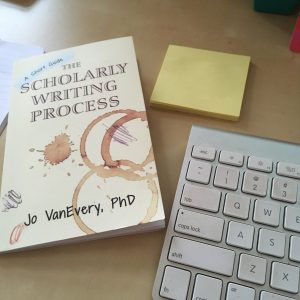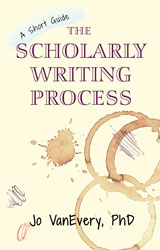Today is the publication date of the first in a series of Short Guides: The Scholarly Writing Process. It seems appropriate to tell you a bit about my own writing process and how this particular guide came to be.
Beginnings
 Last spring I read a review of Liz Gilbert’s Big Magic in Open Letters Monthly partly because I have been conversing with Rohan Maitzen, the author of the review, on Twitter for several years. Her reviews are always interesting.
Last spring I read a review of Liz Gilbert’s Big Magic in Open Letters Monthly partly because I have been conversing with Rohan Maitzen, the author of the review, on Twitter for several years. Her reviews are always interesting.
I reacted strongly to this review. Because I hadn’t read the book being reviewed, my reaction wasn’t really about the accuracy of Maitzen’s interpretation of Gilbert, or disagreement about what Gilbert had to say in Big Magic. Nevertheless, the review made me want to engage with Maitzen’s ideas in the same way that reading Gilbert’s book had made Maitzen want to engage with hers.
I thought I’d write a blog post. It turned into 3 (potential) blog posts. And I wasn’t quite sure “blog post” was the right format for what I wanted to say. I put a piece of my reaction in a comment on the review itself and pondered what else to do with this material. It felt (yes, physically) really important. And yet I didn’t want it to come across as attacking Maitzen personally.
I kept writing. I moved the draft blog posts into a Scrivener project named “creativity, curiosity, fear” because that seemed to be the central theme. I remembered older blog posts I’d written that linked to the themes I was addressing and imported them into the Scrivener project research folder.
I began to imagine a short ebook. I already had in mind a bigger project of turning some of the blog archive into a series of Short Guides and publishing them as ebooks. Maybe this would be one of those.
Getting feedback
At some point I got stuck. I knew there was important material in here but I couldn’t see the main argument. I didn’t know if I was making any sense. I contacted Jane Jones, of Up In Consulting, for developmental editing. I want to recommend editors to my clients and this seemed like an opportunity to see what that process was like and try out an editor I’d met through Twitter.
Jane provided some really helpful advice about what she saw in the draft, along with some ideas for where I could take it. I disagreed with some of her suggestions but, as so often happens, figuring out why I disagreed helped me clarify the direction I did want to take.
Moving the Project Forward
I worked on the structure some more. I identified a central issue: writing is both a process and a product and it helps to separate those heuristically. Furthermore at some stages of the project the process really is more important (a point I understand Gilbert to make) even if there is also a point in the process where the product and its audience becomes more important (a point where I agree with Maitzen).
I created separate folders inside my Scrivener project for the Process and the Products. I kept pulling in more old blog posts, revising them to fit this new structure. I sent another draft back to Jane Jones.
I worked on other things at the same time. I sold a house and moved across an ocean. The whole project was set aside when life took over.
This summer I returned to the project with fresh eyes. I had a flash of inspiration about a structure, and the Short Guides series as a whole: Very Short (<10k words) and not just advice but prompts and questions to help you work out how this advice might apply to your own particular situation. I revised again.
From Process to Product.
And I started researching self-publishing. I joined the Alliance of Independent Authors. I read their guide. A dinner conversation with my partner made me realize that a print version might be like and what the cover could invoke. I worked with my graphic designer. I figured out how to self-publish …
And today I launch the first book in the Short Guides series: The Scholarly Writing Process. It doesn’t really look like a response to Rohan Maitzen’s review anymore but it would not exist had I not read it. It doesn’t look anything like what Jane Jones suggested either but nor would it exist without her expert guidance.
How to get a copy
 The easiest way to get your hands on it is to order the ebook from your favourite online retailer. It’s available in both .mobi (for Kindle) and .epub (for everything else) . If you don’t have an e-reader there are several free apps for whatever computer, tablet, or phone you’d like to read it on. The advantage of these formats over PDF is they resize the page to fit your screen while allowing you to use whatever size font is readable for you.
The easiest way to get your hands on it is to order the ebook from your favourite online retailer. It’s available in both .mobi (for Kindle) and .epub (for everything else) . If you don’t have an e-reader there are several free apps for whatever computer, tablet, or phone you’d like to read it on. The advantage of these formats over PDF is they resize the page to fit your screen while allowing you to use whatever size font is readable for you.
Paperback books are also available to order (ISBN 978-1-912040-00-1) via Amazon or Bookshop.org. They are small. They would fit in your back pocket but more importantly, they won’t take up a lot of room on your desk. I don’t mind if you use your Short Guide as a coaster for your coffee mug. In fact, I’d love it if you did because then when you get stuck with your writing (and you WILL get stuck; that’s part of the process) it will be right there under your mug to help get you unstuck.
Related posts:
You aren’t trying to win an argument in which I point out that the point of publishing is to get a reaction, even if the reaction you get isn’t quite what you’d hoped for








